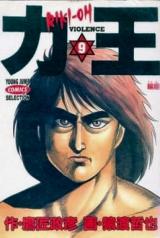Like probably many people, I first encountered Riki-Oh through Lam Ngai Kai's 1991 adaptation. Advertised as one of the most violent movies ever made, I saw it with VCD quality and loved it. The practical effects were amazing, the blood was bright and flowing, spraying, and exploding in buckets, the fights were over-over-the-top insane. And don't get me started on the final bout with the mutated warden...
Recently, I discovered that it's based on a manga, and a long one at that. So, I dug in, wanting to see how much of the film violence came from the original and overall, what did the move from the page to the screen do to the story.
Having finished the entire 12 volume run, I can say that the manga is almost as good as its adaptation. It is hyper violent with blood, brains, eyes, and guts flying left and right on almost every page. It's also very campy, especially in the second half where everything gets batshit crazy and incomprehensible. Weirder and weirder enemies start appearing, some of them with almost magical powers, others from different periods and dimensions. But, by definition, none of them are particularly interesting and exciting, because we know they'll be chopped, eviscerated, or decapitated by Riki in a single blow. Moreover, none of them are given more background than maybe a speech bubble or two, telling us their amazing powers and how they will be the ones to finally destroy the indestructible main character.
It is not the camp, though, that makes this manga more of a letdown. After all, macho campiness and ridiculous powers is what we must expect from a work of this type from the period. Rather, it is the desire of the authors to introduce some kind of epochal seriousness and gravity to Riki's travails. Sprouts of this start appearing after the end of the first prison arc on which the 1991 movie is based. Each of the remaining four arcs starts introducing more unbelievably ridiculous plot twists such as Nazis, religious zealotry, biblical prophecies, pseudo-philosophy, and tons of other things.
With each introduction of a new development and theme, the initial point of the manga seems to be lost more. This is because most plot points were just thrown in by the authors without much attention to what happened or was said in previous chapters and especially arcs. Things happen, new things get introduced, oftentimes contradicting the past, people die, new contradictions are introduced, and so on, until it all ends extremely anticlimactically. I know that strong and logical storytelling isn't to be expected much from such works, but compared to the relative realism and subtlety of the first arc, it looks like a nosedive.
There isn't much of a subtext here, at least not a consistent one that I could catch. There is the running themes of belonging, family, duty, and forgiveness, but they are muddled and shallow. Its more like they were mentioned so the thing can seem semi-serious, not that the authors wanted to explore them. This makes this manga a pretty uninspired read for me, because I prefer it when the violence is used to tell something more meaningful. Here there are is only the pretense of meaning. And this suck, because the setting of the first arc and to a degree, the second one, gives plenty of room for exploring serious topics like corruption, power, policing, control, and others. When Riki breaks the cell wall for the first time in the first part, there is some potentiality for meaning, when he does the same thing for a hundredth time by the final arc, there is none.
What is worse, though, is that the introduction of nazism, teleology, prophecies, and such, negates the impact of the possible critique of the system. All of the occultism of the second part of the manga seems to exonerate the ones who are actually at fault in society, making them powerless pawns in the hands of eternal, otherworldly powers. Moreover, the enemies are almost always framed as being not only powerless in front of Mukai, Riki's father, a would be god, and the ultimate villain, but also people with families and humanity they need to suppress.
Luckily, whereas the storytelling falters as the manga progresses, the art kind of soars. There is nothing mindblowing composition-wise. Most of the panelling is conservative, there are few splash pages, and almost no double page spreads. The ones that appear are also pretty mediocre. The character design is also relatively good, most of the characters look consistent thorough the entire run, with only some contorted faces difficult to understand at points. Luckily, the context helps for them.
The best part by far is the 80's macho hyper violence. It is relatively detailed and realistic, with eyes and brains popping and flying, carcasses hanging and sliding. Most of the action is also comprehensible, but there are some panels in which it is difficult to discern what is happening due to the gore.





